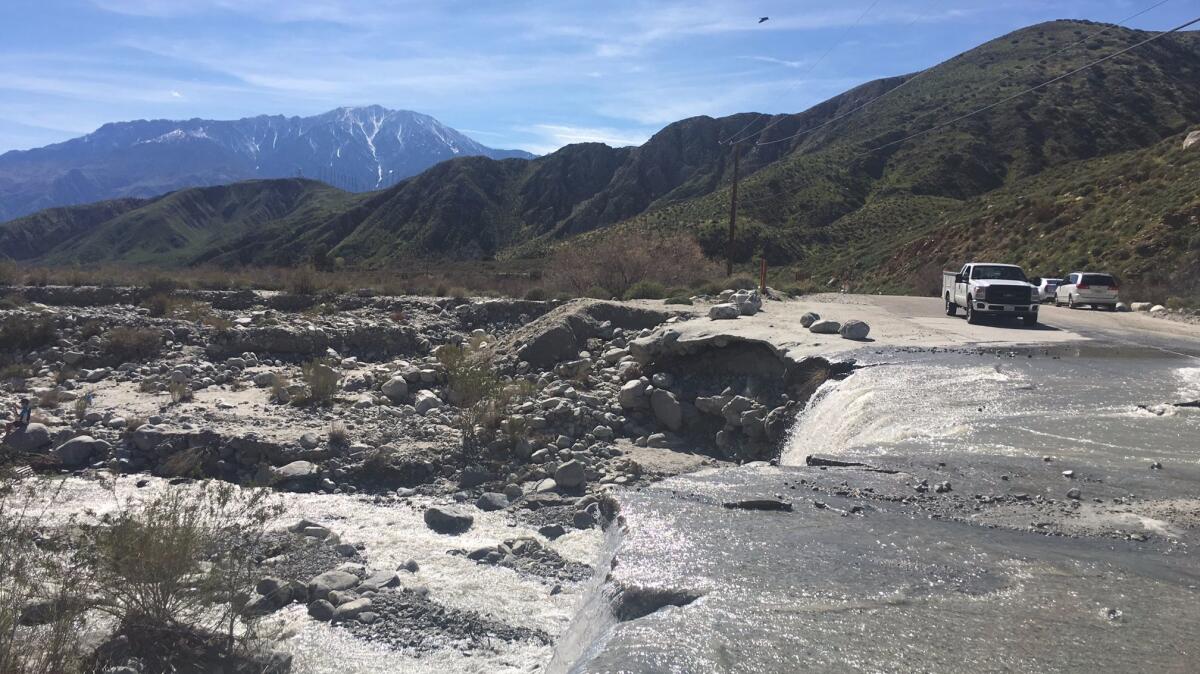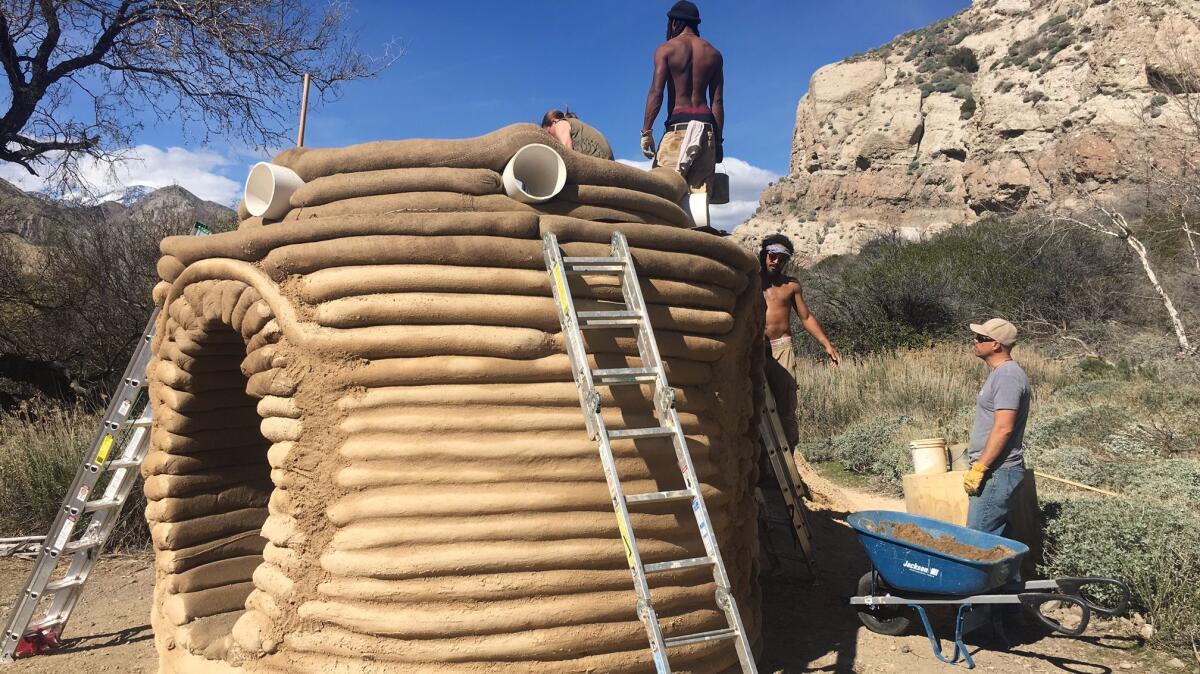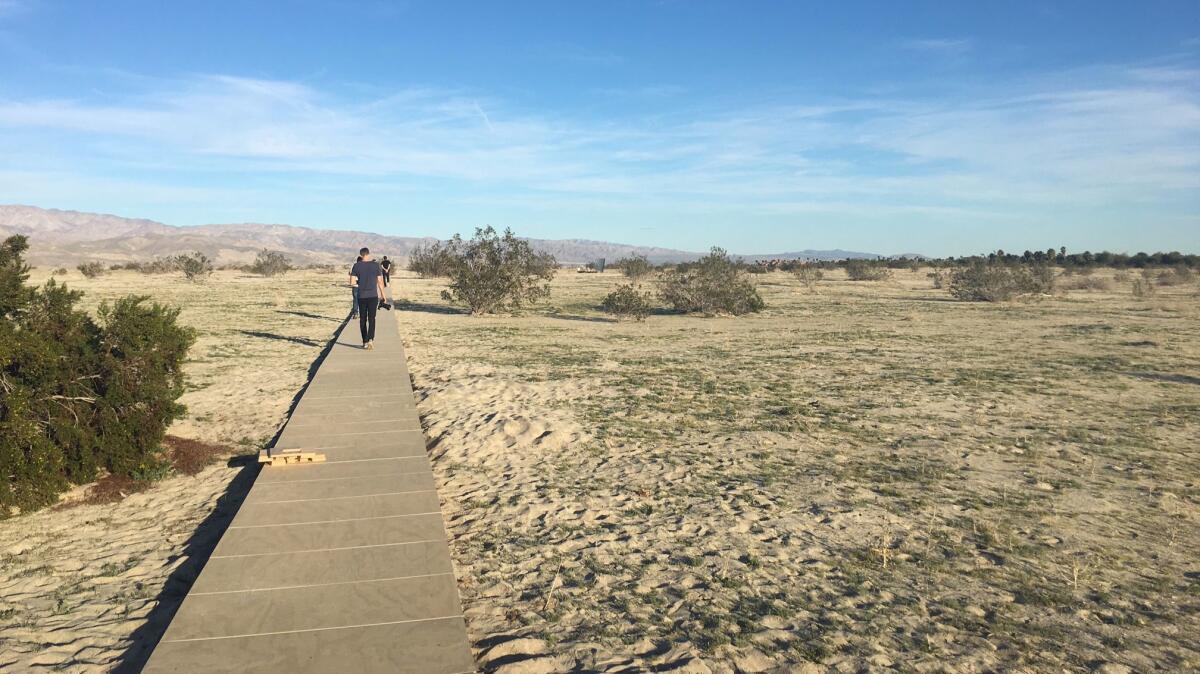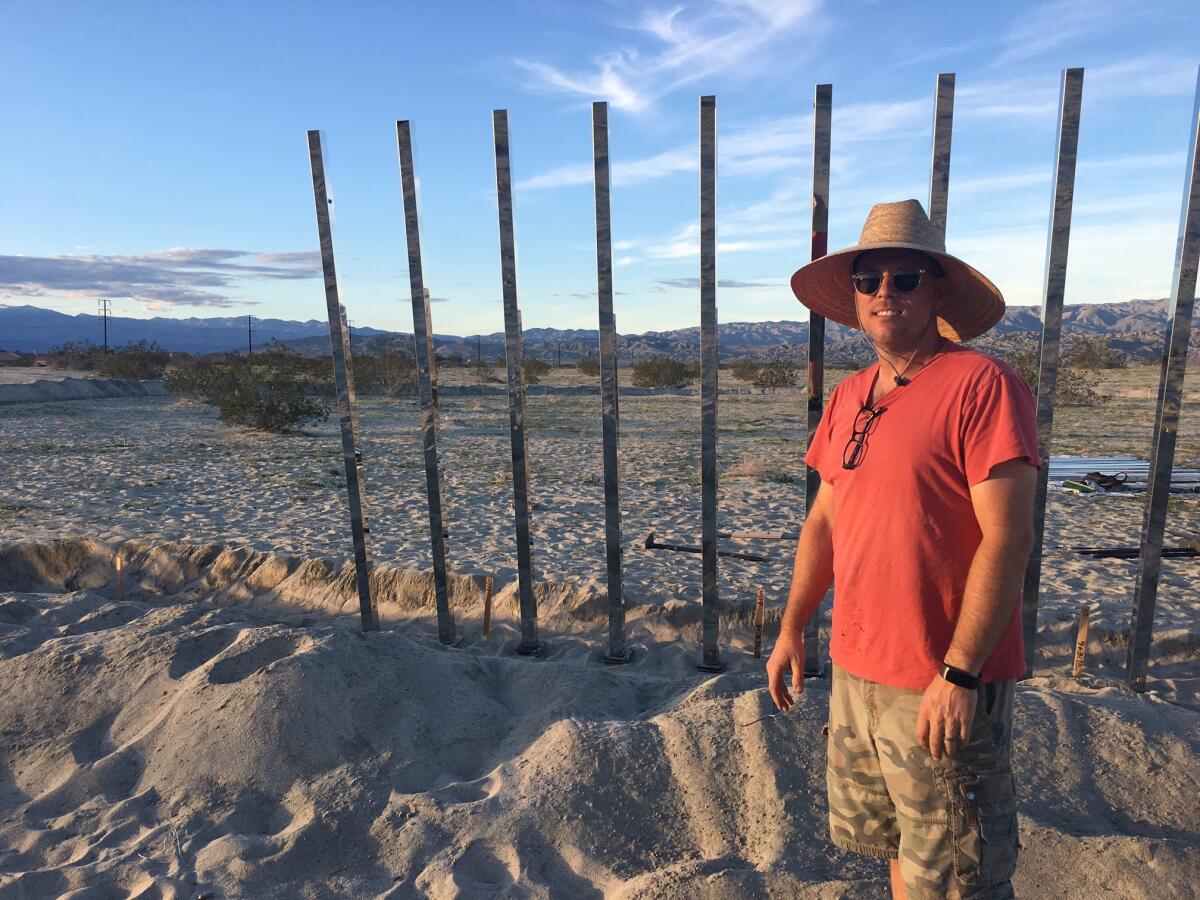Desert X aims to be the Coachella of the art world. Here’s a sneak peek
- Share via
This could be the moon. Or Mars, at dusk. Dozens of craters crowd this desert plot, four acres of scrub brush in Rancho Mirage rimmed by reddish-brown mountains. The holes form half-moon slivers, squares and elongated triangles, each several feet deep and lined with neon tubing. As the sun sinks, the craters glow brighter and brighter, bathing visitors in a golden haze.
New York-based artist Tavares Strachan, who grew up in the Bahamas and says he studied at the Yuri Gagarin cosmonaut training center near Moscow, steps between the cable cords and power generators as a drone zooms above, its engine roaring. It’s capturing aerial pictures of the immersive land and light installation, projected on a video monitor in the back of a nearby truck.
The drone sees a very different picture. From above, the more than 400 craters spell out a simple but suggestive phrase: “I Am!” Tavares says, jubilant, hovering over the monitor during this inaugural test run.
“I’m impressed by how space-like it feels. You experience it so differently on the ground as from above,” he says. “That’s the point.” He gestures at the vast open space, now framed by silhouetted palms on the horizon. “This project — it could only happen in the desert.”
The installation is one of 16 site-specific works in the inaugural Desert X, short for Desert Exhibition of Art, which opens to the public Saturday. The free contemporary art show, steered by a nonprofit group that includes artist Ed Ruscha, collector Beth Rudin DeWoody and former Palm Springs Art Museum director Steven A. Nash, spans about 45 miles of the Coachella Valley, from Whitewater Preserve east to Indio. It strategically bridges Modernism Week, which ends this weekend, and the Coachella Valley Music and Arts Festival and the country music Stagecoach festival in April.
The indoor and outdoor pieces — sculptural, electronic, architectural or performance — are staged on public and private lands. Artists have responded to various aspects of the desert: history, mythology, topography, socioeconomic climate.
“I’m interested in site-specificity and how this place gives rise to the work,” says Neville Wakefield, the British-born, New York-based curator of the exhibition, who led The Times on an early preview as the artworks were being installed. “The show is a sort of refraction of the desert experience through different eyes.”
Visitors to the exhibition will typically start at the Ace Hotel, where they can get a map for a self-guided tour. (Bus tours of select sites will be offered on weekends.)
Two pieces are on view in the Palm Springs Art Museum: a Jeffrey Gibson sculpture made from a wind turbine blade and, during opening weekend, the “nomadic event” titled “Rob Pruitt’s Flea Market.” They’re a short drive from Doug Aitken’s elaborate structure, “Mirage,” and Gabriel Kuri’s earth-filled storefront, “Donation Box,” both in Palm Springs.
“But most of the art is intentionally not clustered together,” Wakefield says. “The idea is to get lost.”
The first stop on Wakefield’s preview is the more remote Whitewater Preserve. As the car rumbles over the gravely roads in a canyon, which is blanketed in sage-green wild grass because of the recent rains, Wakefield explains that Desert X is, at its core, really about the journey between artworks, the surprises and “interstitial moments.” Suddenly, the car comes to a stream of rushing water that cuts across the road, spilling over a nearby cliff hang.

“Whoa, I’ve never seen this out here!” Wakefield says. “See? We’d never have driven out to this point if not for Sherin’s piece. That’s what I’m talking about.”
Just beyond the entrance to Whitewater Preserve is the Sherin Guirguis work that Wakefield speaks of, “One I Call.” The Egyptian-born, L.A.-based artist riffed on a traditional Middle Eastern pigeon tower used in Egyptian villages. A crew of earth-bag construction specialists fills sandbags with loose dirt and layers them around the periphery of the piece, which will rise to about 16 feet. The tenuous structure, which will likely wear down from natural elements, touches on ideas of marginalized desert communities, environmental protection and migration.

Wakefield’s second stop is a high-end housing community under construction. Amid the dust and clamor is the steel skeleton of Aitken’s “Mirage,” which takes the form of a 1960s-style suburban California ranch house. The seven-room structure, to be fully mirrored on the outside and inside, is perched on a hillside with city and desert views, which are key to the piece. The structure has gaping holes where doors and windows might be, and its interior walls are built on angles to reflect the sky and contrasting surrounding terrain — wind farms to the north, residential sprawl to the east and south, the rugged San Jacinto Mountains to the west. As it “pulls in and pushes out the landscape,” Aitken says, the piece functions as a “human scale kaleidoscope” of sorts, with the viewer descending into a prism of textured imagery, shards of different versions of the American dream, past and present.
“In the ’60s and ’70s, this is the kind of generic, California suburban house you wouldn’t notice driving by,” Aitken says later by phone. “We’re taking that house and draining the narrative out of it so it’s just the form itself, the vessel. ‘Mirage’ looks at that twilight area between nature, raw and unobtainable, and nature as something that’s claimed and harvested and controlled. I was acutely interested in the fringe of where the raw landscape meets the developed landscape.”
Desert X is leasing the land for the piece, which will be Aitken’s last major work on the West Coast for “quite some time,” he says. He hopes to partner with a museum to oversee “Mirage,” as it will remain up for at least six months after Desert X ends.
Berlin-based Claudia Comte’s aptly titled “Curves and Zigzags” is more than 110 feet long, a freestanding Op Art mural that’s part painting, part sculpture. The stark and elegant black-and-white piece sits alone in Cap Homme/Ralph Adams Park in Palm Desert, strikingly dividing neat apartment complexes on one side and a vast stretch of open desert on the other. Walk the length of the sculpture, and the painted lines and the physical shape of the wood and stucco wall morph, from soft curves on one end to sharp zigzags on the other.
Amid this dizzying backdrop, Desert X’s two-person production team descends into its own dizzying conversation about Kuri’s storefront installation.
“We need to move 200 tons of sand into a 6,000-square-foot retail space,” says Alexandra Moran, marveling at the complexity of that project.
“And where to find 15 buckets of cigarette butts?” Kamil Beski asks, his head in his hands.
Along the way to Phillip K Smith III’s “The Circle of Land and Sky,” Wakefield explains that the artworks will be open to the public varying hours. Some, in remote locations such as Smith’s, will be accessible 24 hours while others, such as Lita Albuquerque’s marine-blue body cast on white sand at the Sunnylands Center & Gardens in Rancho Mirage, will be accessible only when the institution is open.
Richard Prince’s “Third Place” — a decaying, “cowboy meth-head-style house,” as Wakefield describes it — is in Desert Hot Springs and may be seen by appointment only. Yet other works might never be viewable. The artist Norma Jeane will release an all-terrain robot, programmed to avoid all human contact, into the desert. Created with a San Francisco-based team called Codame, “Shybot” will roam the Coachella Valley for the duration of the exhibition, sporting a video camera to capture its solo journey.
The works, owned by the artists, have been financed by Desert X board members, fundraising events and individual and corporate donors, including several of the municipalities where the works appear.
There’s no way to fully shield open-air works from the elements nor protect unmanned works from vandalism, but that’s part of the point, Desert X founder and board president Susan Davis says. “The desert wears things away and the elements create issues,” Davis says. “There are things you deal with environmentally and otherwise when you move to the desert, whether you’re an art piece or a human being, and we wanted to show that.”
To get to Smith’s artwork, Wakefield follows a narrow wooden footpath seemingly headed into emptiness. There’s nothing but open sky and a distant mountain range before him. But it eventually leads to Smith’s 165-foot circle, rimmed by 10-foot-tall mirrored posts. They’re angled, so standing inside the circle, you see only sky; standing on the outside, you see only land.


“There’s this kind of mixing and bonding and displacement of directions and sense of perception,” Smith says of the work’s opposing reflections as he stands inside the circle. But ultimately, the piece is an ode to its surroundings. “I would hope that people would come to this piece to see the artwork, and the beauty that’s there, and leave understanding the beauty of the desert. It’s as simple as that.”
Most of the Desert X works will be disassembled after the exhibition ends, though several artists are creating documentation that will live on in other forms. Strachan is making a book, “Shybot’s” footage may be screened publicly, and institutions such as the Palm Springs Art Museum could acquire certain works, Davis says.
The future of Desert X, however, is as wide open as the desert landscape itself, Wakefield says, as he leaves Strachan’s moonscape.
In the car’s rearview mirror, the craters glimmer as the drone, now just a red dot in the sky, circles above.
“The only thing we know is that this is the first iteration of a recurring show,” Wakefield says of Desert X. “Maybe it’s every three years, maybe there’s one next year, who knows? This is about surprises.”
Follow me on Twitter: @debvankin
ALSO
Beyoncé, Radiohead, Kendrick Lamar top 2017 Coachella lineup
Coachella’s 2017 lineup reflects America and refracts its troubles
Marciano Art Foundation sets L.A. museum opening date for May
A throwback no more: Coachella is finally laying off the reunions
More to Read
The biggest entertainment stories
Get our big stories about Hollywood, film, television, music, arts, culture and more right in your inbox as soon as they publish.
You may occasionally receive promotional content from the Los Angeles Times.











